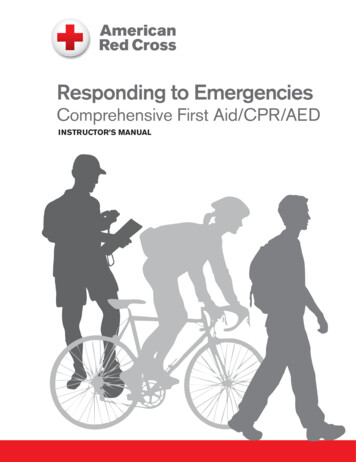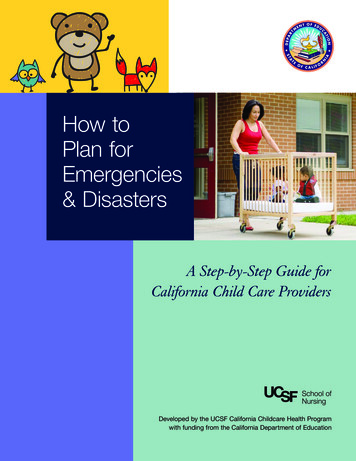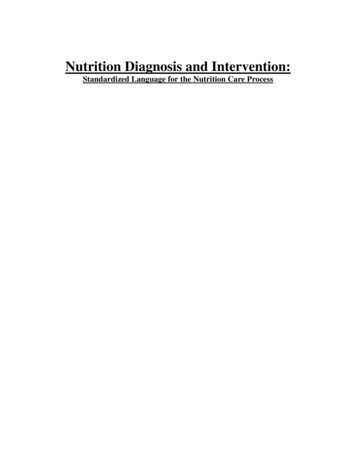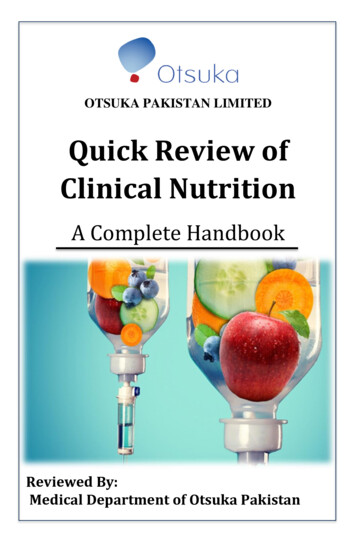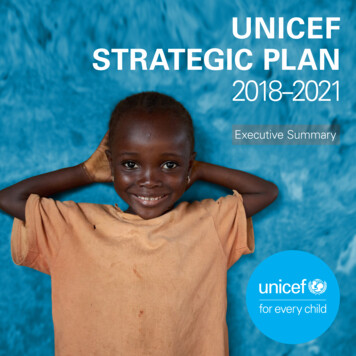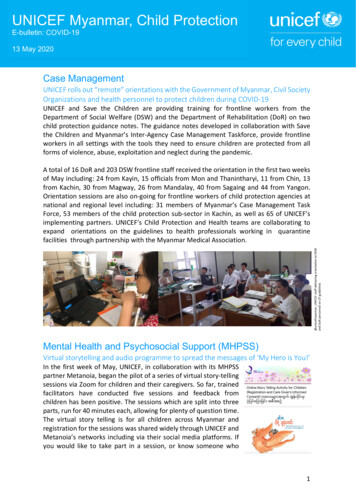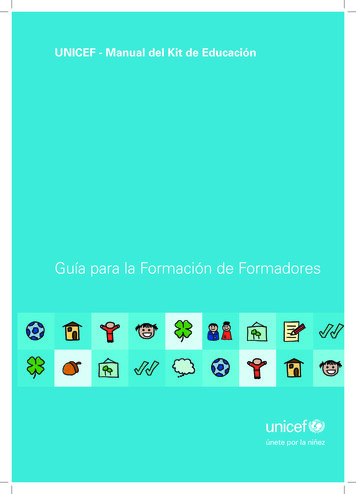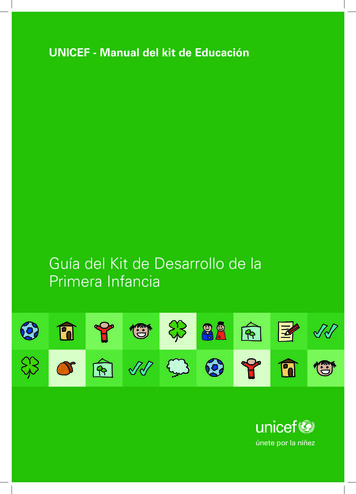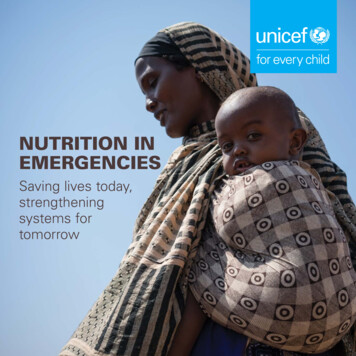
Transcription
NUTRITION INEMERGENCIESSaving lives today,strengtheningsystems fortomorrow1
She’s been walking for days. Her body achesand her stomach is empty when she finallyreaches the refugee camp. With her baby slunglow on her back, she searches for a safe placeto rest and feed him. The ground is litteredwith debris and everywhere she looks thereare people.The task before her seems enormous:find food, safe water and a clean place to restand breastfeed her baby.for every child, nutrition2
NUTRITION ATA BREAKING POINTThe world is facing an unprecedented numberof humanitarian situations today. Protractedconflicts, natural disasters and devastating foodinsecurity grip communities around the world, threateninglives and livelihoods – and women and children bear thegreatest consequences. By the end of 2016, more thanhalf a billion children were living in countries affected byconflict, disasters and epidemics. Humanitarian crisesare often characterized by limited access to safe foodand clean water as well as disruptions to basic health andnutrition services – a lethal cocktail of undernutrition.To protect children’s right to food and nutrition inemergencies, UNICEF and its partners identify and treatchildren suffering from acute malnutrition, provide fortifiedfoods and supplements to prevent vitamin and nutrientdeficiencies, protect and promote breastfeeding, andsupport families in providing safe and nutritious food foryoung children. In the past year alone, UNICEF respondedto 344 humanitarian situations of varying scale in 108countries – the largest number of situations and countriesin more than a decade.To say this work is urgent is an understatement.Malnutrition is deadly: a child suffering from severe acutemalnutrition is nine times more likely to die than a wellnourished child. But the dire consequences of malnutritionare not always visible from the outside. Poor dietsalso inflict devastating damage on the inside, stuntingchildren’s growth, impairing their brain developmentand leaving them susceptible to disease. UNICEF’snutrition programmes aim to foster children’s growth anddevelopment over the long term, ensuring they not onlysurvive but go on to live healthy and productive lives.During humanitarian crises, UNICEF’s foremost prioritiesare to prevent death from starvation and disease andto reduce malnutrition. This work is guided by the CoreCommitments to Children in Humanitarian Action – aglobal framework for fulfilling the rights of childrenaffected by humanitarian crisis. In a nutrition emergency,every second counts: a timely, coordinated responsehas the power to safeguard children’s minds, bodies andfutures.3
4
Laying the groundwork foremergency responsePlanning and emergency preparedness are the foundations ofeffective humanitarian action.Preventing malnutrition before it starts – UNICEFworks to build the foundations of good nutrition –including access to nutritious foods during pregnancy andearly childhood, access to basic services and a safe andhealthy environment – to keep children strong and resilientin the face of disease and disaster.Identifying and managing risks – UNICEF helpscountries anticipate threats to good nutrition and developrisk-informed systems and programmes that are flexibleand poised to adapt when emergency strikes.Directing a coordinated response – Within countries,UNICEF is mandated as the lead agency for nutrition,heading emergency coordination efforts in more than 60countries. UNICEF also leads the Global Nutrition Cluster— a body tasked with ensuring a timely, well-coordinatedand effective response where the scale of emergency isso large that no single agency or national authority canaddress it alone.Strengthening systems and strategies – UNICEF helpsgovernments plan for emergencies by putting the rightpolicies, programmes and strategies in place ahead oftime – and securing the human resources needed to scaleup emergency response when needed.Tracking nutrition information – UNICEF supportscountries in monitoring and collecting national data onmalnutrition that can help them make critical decisionsbefore, during and after a crisis.5
6
Delivering urgent treatmentand care in crisisWhen disaster strikes, UNICEF is on the ground delivering emergency nutrition tothe children and families who need it most.Providing leadership under pressure – UNICEF workswith governments to conduct rapid nutrition assessmentsto identify gaps and vulnerabilities and to coordinate a planof action among multiple partners.Working to keep good nutrition inside the body –UNICEF improves access to clean water and adequatesanitation during emergencies to prevent diarrhoealdiseases, which can deplete children’s nutrient stores andleave them vulnerable to malnutrition.Preventing hidden hunger with vitamins andessential nutrients – UNICEF provides vitaminsupplementation and fortified foods to womenand children – such as vitamin A, iodized salt andmicronutrient powders – to prevent nutrient deficienciesand other forms of malnutrition. Supplementation boostschildren’s immunity and can even save lives: for example,two-doses of vitamin A can reduce child mortality by 1224 percent.Managing life-saving treatment and care – Whenprevention fails, UNICEF delivers urgent, life-savingtreatment and care for children suffering from severeacute malnutrition. In the past year alone, UNICEF treated2.4 million children with severe acute malnutrition inhumanitarian situations.Protecting and supporting breastfeeding – UNICEFprovides counselling to mothers and caregivers andestablishes safe spaces for feeding children in times ofcrisis. In 2016, more than 6.3 million caregivers receivedsuch counselling with UNICEF support. Where infantformula is required, UNICEF provides monitoring andoversight to ensure it is distributed ethically.7
8
Leading the way backfrom disasterUNICEF supports countries as they rebuild and recover after crisis.Monitoring and surveillance – UNICEF tracks thenutrition situation during emergencies and advisescountries on the way forward as they transition out ofcrisis and improve future disaster risk reduction efforts.Advocating for change – As contexts shift, UNICEFhelps countries adapt emergency nutrition programmesinto effective long-term strategies. For example,UNICEF advocates for the treatment of severe acutemalnutrition to be funded by domestic budgets andintegrated into routine health services for children.Fostering resilience – UNICEF supports countries inbuilding and strengthening polices and systems to helpcommunities anticipate, withstand, and bounce back fromshocks and stressors.UNICEF collaborates across sectors at every stage of the process – frompreparedness, to response, to recovery – in recognition of the multipledeterminants of malnutrition in emergencies. Leveraging its strength asan agency with expertise across multiple sectors, UNICEF’s strategiesand delivery platforms combine nutrition, health, water, sanitation andhygiene interventions to guarantee a rapid and holistic response.9
10
All hands on deck:An integrated chain of responseTo be effective, the national responseto nutrition emergencies needs tobe based on data and grounded inevidence about what works. It needsto be coordinated. It needs adequatehuman and financial resources.And it needs standards to ensurethat services reach and impact thechildren and families who need itmost.Countries in the depths of crisiscannot do this work alone. Theyneed the support of global andregional actors – a chain of responsefrom global to country level – toguarantee that standards aretranslated into actions and results thatuphold children’s rights. UNICEF’sregional and headquarters officesprovide this critical support andoversight to the urgent work takingplace on the ground.UNICEF’s regional office takes onthe role of:UNICEF’s global headquartersprovides the value of:Mobilizer – gathering resources,mobilizing surge capacity anddeploying staff to fill gaps and supporthumanitarian response.Technical expert – gatheringevidence, developing normsand standards for emergencypreparedness and response andcoordinating a global technicaladvisory body to tackle new andemerging issues;Convenor – uniting partners,engaging with regional bodies andcoordinating regional strategies.Knowledge broker – documentingbest practices and lessons learnedand ensuring new knowledge informsthe emergency response in othercountries in the region.11Quality assurer – forging a clearpathway to results and ensuringthe latest technical guidance isimplemented in times of crisis;Data custodian – equippingcolleagues on the ground with thelatest data, and monitoring andtracking the nutrition situationlonger-term.
12
SNAPSHOTS OFEMERGENCY NUTRITIONIN MOTION13
Bachuy Riak, 7, stands next to his motherAngelina Nyanin, 25, holding her niece, NyalelGatcauk, 2, who suffers from malnutrition,during a Rapid Response Mechanism (RRM)mission in Thonyor, Leer county, South Sudan. UNICEF/UN055446/Modola14
Partnering to save lives in the mostfragile communities in South Sudanand support for children with severe acutemalnutrition, UNICEF worked with WPFto develop the South Sudan’s first-evernational community-based care guidelinesfor children with acute malnutrition. Theguidelines will accelerate care for thechildren most in need by allowing them betreated right within their own homes andcommunities.The protracted crisis in South Sudanhas left children facing immediate risksof violence, displacement, hunger andlife-threatening disease. In 2016, itsthird year of emergency response, UNICEFand the World Food Programme (WFP)provided life-saving services through 19integrated ‘rapid response mechanism’missions, delivering food rations andservices to prevent and treat acutemalnutrition. First launched in 2014, thesemissions have been pivotal to ensuringthat children in remote communitiescut off from services have a chance atsurvival. As part of the missions, UNICEFand WFP screened more than 61,000children under 5 and more than 15,000pregnant and lactating women for acutemalnutrition and referred those in need forlifesaving treatment and care. Nationwide,in partnership with 47 non-governmentalorganizations, UNICEF treated more than2018,000 children under 5 for severeacute malnutrition across the country,and more than 86 per cent of thesechildren recovered. To strengthen careUNICEF and its partners worked to trainhealth workers to better support infantand young child feeding during crisis.With UNICEF’s technical support, morethan 2,900 staff from NGOs and stateministries of health were trained to supportmothers in crisis. And with this improvedcapacity, more than 735,000 pregnantwomen and mothers with young childrenwere reached with individual counsellingand support, while a further 650,000men and women benefitted from groupcounselling. This counselling providedcritical skills to improve breastfeedingpractices and prevent malnutrition.15
Porters and a local health official carry UNICEFprovided vaccines on difficult terrains on theway to a measles, rubella and polio vaccinationcampaign to be conducted at Barpak VillageDevelopment Committee (VDC) health post inGorkha District, the epicentre of the April 25earthquake. UNICEF/UNI199142/Panday16
Delivering high-impact servicesand building resilience in NepalAfter the devastating earthquake inNepal in 2015, the Nutrition Cluster, ledby the Ministry of Health and Populationand UNICEF, and comprising 28 nationaland international partners, devised athree-month emergency response planto prevent malnutrition in this vulnerablepopulation. UNICEF and the NutritionCluster trained more than 16,000 healthworkers and community volunteersto deliver a package of key nutritioninterventions to more than 460,000children under 5 as well as pregnant andlactating women. To prevent vitamin andnutrient deficiencies, more than 300,000children received micronutrient powders,more than 360,000 received lifesavingvitamin A supplementation and morethan 24,000 women benefitted fromiron and folic acid supplementation toprevent anaemia. Thousands of motherswith children under 2 received on-siteface to face counselling and support onbreastfeeding and more than 370,000children under 5 were screened for severeacute malnutrition.Nepal’s nutrition response to theearthquake is a case study in resilience.The effectiveness of the responsewas rooted in the experience,capacities and systems that had beendeveloped prior to the emergencyas part of the EU-funded Maternaland Young Child Nutrition SecurityInitiative in Asia programme. Theemergency response made use ofcoordination mechanisms that hadbeen strengthened during the previousyears, highlighting the importance ofincluding resilience building in the designand implementation of all developmentprogrammes.17
A mother from Luhansk feeding her baby whiletaking part in the workshop “Breastfeedingand infant feeding of children in emergencies”organized by UNICEF. UNICEF/UNI194033/Zavalnyuk18
Protecting the rights of breastfeedingmothers and their children inconflict-affected areas of UkraineIn 2016, UNICEF continued to contributeto the emergency response, supportingbreastfeeding counselling for nearly44,000 pregnant and lactating women.UNICEF also helped train 800 healthprofessionals in the government-controlledareas of Donetsk and Luhansk oblasts,making them better equipped to supportbreastfeeding mothers during the crisis.UNICEF also worked to monitor andprevent the indiscriminate distribution ofbreastmilk substitutes, including by traininghealth providers. With technical supportfrom UNICEF, Ukraine’s Ministry of Healthestablished a monitoring system in 35affected areas to better track the nutritionsituation of infants and pregnant women.Breastfeeding was negatively impactedby the conflict in Ukraine, with a 2015assessment showing that only 26percent of internally displaced childrenunder 6 months were exclusivelybreastfeeding and many mothers werenot receiving adequate support fromthe health system. In response, UNICEFsupported a capacity building workshopfor health workers on supporting infantfeeding in emergencies and worked jointlywith other Nutrition Sub-Cluster membersto monitor the distribution of breastmilksubstitutes while strengthening support forbreastfeeding. UNICEF’s advocacy helpedgarner political commitment from theGovernment of Ukraine to protect, promoteand support breastfeeding. By the end ofthe year, more than 73,400 mothers inconflict-affected areas had been reachedwith information on the benefits ofexclusive breastfeeding in emergencies.19
Community care centres provide isolation areasand basic care for people suspected of havingEbola virus disease (EVD) who are awaiting theresult of their diagnostic tests and – if their testresult is positive – transfer to Ebola treatmentcentres. UNICEF/UNI178352/Naftalin20
Developing urgent technical guidance todirect the Ebola response in West AfricaAt the same time, UNICEF collaboratedwith WHO and other partners to developclear, evidence-based global guidelineson infant and young child feeding in thecontext of Ebola over the long-term. Torespond to the new guidance, UNICEFcountry offices procured ready-to-useinfant formula and closely monitoredits use and distribution while affectedgovernments worked to modify theirpolicies and approaches.The 2014 Ebola crisis in West Africasparked urgent questions aboutsafe feeding practices for infantsand young children given the lack ofglobal norms and standards on theissue. Feeding infants and young childrenrequires close physical contact andEbola can be transmitted via breast milkand other bodily fluids, highlighting theneed for guidance on how to guaranteesafe and nutritious foods for children inthis challenging context. To respond toimmediate needs, UNICEF headquartersand regional offices provided urgenttechnical support and guidance to assistcountries in the midst of crisis.21
22
Bridging the gaps to drive resultsPutting the emergency chain of response into action is complex, resource intensive– and it works. Yet, garnering the resources to support all actions, from countrylevel to headquarters, has been an ongoing challenge for UNICEF.The faces of children on the brink ofstarvation rightly touch the world’scollective consciousness and donorsare eager to fund urgent nutritionservices on the ground whendisaster strikes. More challenginghowever, has been securing theresources to drive UNICEF’s regionaland global actions – which ultimatelyprevent malnutrition and save lives– but which tend to occur behindthe scenes.UNICEF as the lead agency fornutrition in emergencies is expectedto provide reliable and predictabletechnical expertise. This is moreimportant than ever given thecomplex and rapidly changingface of nutrition emergencies.For example, humanitarian crisesare increasingly taking place inmiddle income countries with lowbreastfeeding rates (emphasizingthe need to define approachesfor non-breastfed children) or insettings where populations faceoverlapping problems of stunting,overweight and micronutrientdeficiencies. During emergencies,pressing technical questions arisefrom countries desperate to respondswiftly to an emerging issue, suchas the Ebola crisis discussed above.To support countries in respondingto these issues, UNICEF will begincoordinating a global platformto tackle unresolved technicalquestions in humanitarian contexts.Today, one of the most immediate23gaps UNICEF faces is sheer humanresource power. Regional surgemechanisms cannot functioneffectively without adequate surgestaff. There is an urgent need forresources to support a roster ofexperts than can be deployed tosupport rapid humanitarian response.Resources to support countries inpre-emergency planning and systemsstrengthening continue to be limited.Many countries move in and out ofcrisis over time, and the changingnature of emergencies means thatfostering nutrition resilience withincommunities and nations has neverbeen more important.
24
What will it take?Emergencies call for rapid action at all levels to protect children’s right to nutritiousfood and safe and healthy environments.With predictable and flexible funding, we can give45 UNICEF country offices, seven regional officesand headquarters the support they need to fosteremergency preparedness and scale up key maternaland child nutrition interventions in humanitariancontexts. With greater funding, we can help GlobalNutrition Cluster partners and governments upholdthe rights of children and women even in the mosttrying of circumstances. We know what works – andwith greater investments, we have the power to makeit happen.Despite the rising scale and scope of emergenciesworldwide, this work remains vastly underfunded.Preventive actions in emergencies – such as supportfor improving infant and young child feeding – andthe actions of regional and headquarters offices areparticularly neglected.We can change this. With greater investments, wecan prevent malnutrition before it starts, providelifesaving treatment when prevention fails, andbuild resilience among families and communities.25
26
For more information about UNICEF’snutrition in emergencies work, contact:Diane HollandSenior Nutrition Advisor & Nutrition in Emergencies Programme Leaddholland@unicef.orgRuth SitumaNutrition Specialist & Nutrition in Emergencies Result Managerrsituma@unicef.org27
United Nations Children’s Fund (UNICEF)June 2018Nutrition SectionProgramme DivisionUNICEF3 United Nations PlazaNew York, NY 10017http://www.unicef.org/nutrition/Photo credits: cover: UNICEF/UN061105/Knowles-Cours; page 4: UNICEF/UN056152/Romenzi; page 5: UNICEF/UN0119074/Sokhin;page 6: UNICEF/UN073270/Dubourthoumie;page 7: UNICEF/UN068636/Oatway; page8: UNICEF/UN055440/Modola; page 14: UNICEF/UN028844/Tremeau; page 15: UNICEF/UN0148008/Gilbertson V; page 16: UNICEF/UN08217/Holt28
countries anticipate threats to good nutrition and develop risk-informed systems and programmes that are flexible and poised to adapt when emergency strikes. Directing a coordinated response - Within countries, UNICEF is mandated as the lead agency for nutrition, heading emergency coordination efforts in more than 60 countries.

